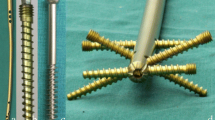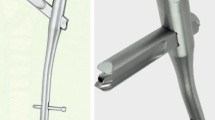Abstract
Introduction
The advantages of intramedullary fixation of pertrochanteric hip fractures over dynamic screw-plate devices in the clinical setting are still a matter of debate. We performed a case series study in a teaching hospital to analyse the results of the recent AO-ASIF proximal femoral nail (PFN).
Materials and methods
Between July 1998 and May 2001, 46 consecutive patients (47 fractures) were included in the investigation. The average patient age was 76.4 years (range 50–93 years), and most fractures (74.5%) were unstable. Operative details, adequacy of fracture reduction, screw position in the femoral head, re-operations, and postoperative complications were documented. Functional results were evaluated by the Parker and Palmer mobility score and Barthel Index for patients with a minimum follow-up of 4 months.
Results
Intraoperative technical or mechanical complications occurred in 11 patients (23.4%), mostly problems with the distal nail locking and fracture of the lateral wall of the greater trochanter. Mean surgical time was 83.4 min. The lateral protrusion of screws causing thigh pain was the most common postoperative complication, with an incidence of 21.2%. There was only one femoral shaft fracture at the nail tip caused by a fall at 9 months of follow-up. Five patients (10.6%) had intra-articular migration of screws, which was associated with loss of reduction and varus collapse in one case. There were 2 persistent deep infections and 2 haematomas that required surgical drainage. The re-operation rate was 19.1%, mainly cephalic screw removal due to lateral protrusion at the proximal thigh. Ten patients (32.2%) fully recovered their Parker and Palmer mobility score, and 20 patients (66.6%) recovered more than 90% of their pre-injury Barthel Index values. The average limb shortening was 14 mm. Mortality rate during the observation period was 20.4%.
Conclusion
In view of only one loss of reduction with varus collapse clearly caused by a technical error, we concluded that the PFN is a suitable implant for unstable fractures, but the high re-operation rate precludes its routine use for every pertrochanteric fracture.


Similar content being viewed by others
References
Adams CI, Robinson CM, Court-Brown CM, McQueen MM (2001) Prospective randomized controlled trial of an intramedullary nail versus dynamic screw and plate for intertrochanteric fractures of the femur. J Orthop Trauma 15:394–400
Baumgaertner MR, Curtin SL, Lindskog DM, Keggi JM (1995) The value of tip-apex distance in predicting failure of fixation of peritrochanteric fractures of the hip. J Bone Joint Surg Am 77:1058–1064
Baumgaertner MR, Curtin SL, Lindskog DM (1998) Intramedullary versus extramedullary fixation for the treatment of intertrochanteric hip fractures. Clin Orthop 348:87–94
Bellabarba C, Herscovici D Jr, Ricci WM (2000) Percutaneous treatment of peritrochanteric fractures using the gamma nail. Clin Orthop 375:30–42
Bridle SH, Patel AD, Bircher M, Calvert PT (1991) Fixation of intertrochanteric fractures of the femur. A randomized prospective comparison of the gamma nail and the dynamic hip screw. J Bone Joint Surg Br 73:330–334
Butt MS, Krikler SJ, Nafie S, Ali MS (1995) Comparison of dynamic hip screw and gamma nail: a prospective, randomized, controlled trial. Injury 26:615–618
Calvert PT (1992) The gamma nail—a significant advance or a passion fashion? J Bone Joint Surg Br 74:329–331
Curtis MJ, Jinnah RH, Wilson V, Cunningham BW (1994) Proximal femoral fractures: a biomechanical study to compare intramedullary and extramedullary fixation. Injury 25:99–104
Domingo LJ, Cecilia D, Herrera A, Resines C (2001) Trochanteric fractures treated with a proximal femoral nail. Int Orthop 25:298–301
Dujardin FH, Benez C, Polle G, Alain J, Biga N, Thomine JM (2001) Prospective randomized comparison between a dynamic hip screw and a mini-invasive static nail in fractures of trochanteric area: preliminary results. J Orthop Trauma 15:401–406
Gundle R, Gargan MF, Simpson HRW (1995) How to minimize failures of fixation of unstable intertrochanteric fractures. Injury 26:611–614
Haentjens P, Autier P, Barette M, Boonen S (2001) The economic cost of hip fractures among elderly women. A one-year, prospective, observational cohort study with matched-pair analysis. J Bone Joint Surg Am 83:493–500
Halder SC (1992) The gamma nail for peritrochanteric fractures. J Bone Joint Surg Br 74:340–344
Hardy DCR, Descamps PY, Krallis P, Fabeck L, Smets P, Bertens CL, Delince PE (1998) Use of an intramedullary hip-screw compared with a compression hip screw with a plate for intertrochanteric femoral fractures. A prospective, randomized study of one hundred patients. J Bone Joint Surg Am 80:618–630
Harrington P, Nihal A, Singhania AK, Howell FR (2002) Intramedullary hip screw versus sliding hip screw for unstable intertrochanteric femoral fractures in the elderly. Injury 33:23–28
Haynes RC, Pöll RG, Miles AW, Weston RB (1997) Failure of femoral head fixation: a cadaveric analysis of lag screw cut-out with the gamma locking nail and AO dynamic hip screw. Injury 28:337–341
Jensen JS (1980) Classification of trochanteric fractures. Acta Orthop Scand 51:803–810
Jensen JS, Sonne-Holm S, T∅ndevold E (1980) Unstable trochanteric fractures. A comparative analysis of four methods of internal fixation. Acta Orhtop Scand 51:949–962
Kane M, Kyle RF, Loch DA, Bechtold JE (1993) Biomechanical analysis of the sliding characteristics of the proximal screw of second generation intramedullary screws. J Orthop Trauma 7:191–192
Keating JF, Robinson CM, Court-Brown CM, McQueen MM, Christie J (1993) The effect of complications after hip fractures on rehabilitation. J Bone Joint Surg Br 75:976
Leung KS, So WS, Shen WY, Hui PW (1992) Gamma nails and dynamic hip screws for peritrochanteric fractures. A randomized prospective study in elderly patients. J Bone Joint Surg Br 74:345–351
Loch DA, Kyle RF, Bechtold JE, Kane M, Anderson K, Sherman RE (1998) Forces required to initiate sliding in second-generation intramedullary nails. J Bone Joint Surg Am 80:1626–1631
Mahomed N, Harrington I, Kellam J, Maistrelli G, Hearn T, Vroemen J (1994) Biomechanical analysis of the gamma nail and sliding hip screw. Clin Orthop 304:280–288
Mahoney FI, Barthel DW (1965) Functional evaluation: the Barthel Index. A simple index of independence useful in scoring improvement in the rehabilitation of the chronically ill. Md State Med J 13:61–65
Müller ME, Nazarian S, Koch P, Schatzker J (1990) The comprehensive classification of fractures of long bones. Springer Verlag, Berlin Heidelberg New York
Navarro-Quilis A, Carrera LL, Pellise F, Aguirre M (1992) Condylocephalic nailing in pertrochanteric fractures. Clin Orthop 283:91–97
O'Brien PJ, Meek RN, Blachut PA, Broekhuyse HM, Sabharwal S (1995) Fixation of intertrochanteric hip fractures: gamma nail versus dynamic hip screw. A randomized, prospective study. Can J Surg 38:516–520
Osnes EK, Lofthus CM, Falch JA, Meyer HE, Stensvold I, Kristiansen IS, Nordsletten L (2001) More postoperative femoral fractures with the gamma nail than sliding screw plate in the treatment of trochanteric fractures. Acta Orthop Scand 72:252–256
Palmer SJ, Parker MJ, Hollingworth W (2000) The cost and implications of reoperation after surgery for fracture of the hip. J Bone Joint Surg Br 82:864–866
Parker MJ (1992) Cutting-out of the dynamic hip screw related to its position. J Bone Joint Surg Br 74:625
Parker MJ, Palmer CR (1993) A new mobility score for predicting mortality after hip fracture. J Bone Joint Surg Br 75:797–798
Parker MJ, Pryor GA (1996) Gamma versus DHS nailing for extracapsular femoral fractures. Meta-analysis of ten randomized trials. Int Orthop 20:163–168
Radford PJ, Needoff M, Webb JK (1993) A prospective randomized comparison of the dynamic hip screw and the gamma locking nail. J Bone Joint Surg Br 75:789–793
Rosenblum SF, Zuckerman JD, Kummer FJ, Tam BS (1992) A biomechanical evaluation of the gamma nail. J Bone Joint Surg Br 74:352–357
Sadowski C, Lübbeke A, Saudan M, Riand N, Stern R, Hoffmeyer P (2002) Treatment of reverse oblique and transverse intertrochanteric fractures with use of an intramedullary nail or 95º screw-plate. J Bone Joint Surg Am 84:372–381
Saudan M, Lübbeke A, Sadowski C, Riand N, Stern R, Hoffmeyer P (2002) Pertrochanteric fractures: is there an advantage to an intramedullary nail? A randomized, prospective study of 206 patients comparing the dynamic hip screw and proximal femoral nail. J Orthop Trauma 16:386–393
Simmermacher RKJ, Bosch AM, Van der Werken C (1999) The AO/ASIF-proximal femoral nail (PFN): a new device for the treatment of unstable proximal femoral fractures. Injury 30:327–332
Simpson AHRW, Varty K, Dodd CAF (1989) Sliding hip screws: modes of failure. Injury 20:227–231
Tigani D, Laus M, Betelli G, Boriani S, Giunti A (1992) The gamma nail, sliding compression plate. A comparison between the long-term results obtained in two similar series. Chir Organi Mov 77:151–158
Valverde JA, Alonso MG, Porro JG, Rueda D, Larrauri PM, Soler JJ (1998) Use of gamma nail in the treatment of fractures of the proximal femur. Clin Orthop 350:56–61
Acknowledgements
We would like to thank Dr. Jürgen Stadler (Bad Säckingen, Germany) for his valuable comments and suggested readings. No benefits in any form have been received or will be received from a commercial party related directly or indirectly to the subject of this article. No funds were received in support of this study.
Author information
Authors and Affiliations
Corresponding author
Rights and permissions
About this article
Cite this article
Fogagnolo, F., Kfuri, M. & Paccola, C.A.J. Intramedullary fixation of pertrochanteric hip fractures with the short AO-ASIF proximal femoral nail. Arch Orthop Trauma Surg 124, 31–37 (2004). https://doi.org/10.1007/s00402-003-0586-9
Received:
Published:
Issue Date:
DOI: https://doi.org/10.1007/s00402-003-0586-9




